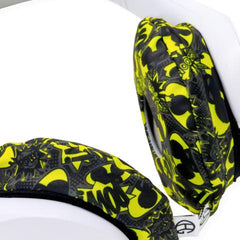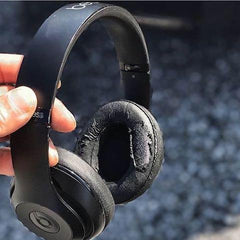Why is my gaming headset Causing Sweaty Ears?

Headsets and headphones are important to gamers. They allow for immersion: the sound of footsteps behind or gunfire volleys to the left or right. They’re great, too, if you live in a noisy household as even the most basic on-ear or over-head pair will provide some level of passive noise-cancellation, and they’re a way of communicating with other players so, for many gamers, they’re an integral part of the set-up.
But if you play regularly and for extended periods, you might find that your gaming headset is causing sweaty ears.
It’s pretty common and not just with gamers. It happens to audiophiles, too, and to anyone who spends long periods wearing on-ear or over-ear headphones.
We wanted to explain why this happens, why sweaty ears can be bad for your headset and to explore if there are any headphone protection you can use to help.
Why headphones are making your ears sweat
Headphones stay on your head thanks to the clamping effect. This is just the pressure your earpads apply to your ears and head when you’re wearing them. Too much pressure and they’re uncomfortable and painful, and too little and they’ll just slide right off your head. For this post, we’re not concerned with the pressure itself but rather how the clamping effect seals the cushion to your ear.
With the earcup clamped to the ear, it’s going to get warm under there.
What’s important, too, is the material covering the earcups. Leather and pleather are often the worst culprits as neither is breathable making it more likely you’ll sweat into them.
And some people just sweat more. You could have more sweat glands than someone else or you could have a condition where you sweat excessively. If you’re playing in a warm room, you’ll sweat into your headphones more frequently.
Why sweat can damage headphones
Most headphones will handle some sweat without a problem. What we’re talking about is when they’re exposed to moisture regularly – for example, if you’re playing every day or for many hours each week.
Sweat is corrosive so when it’s allowed to sit on the cushion and then seep inside it, the material can start breaking down. Often this manifests as a tear or rip in the material that then gets worse or forms as small flakes that get onto your clothes and ears. This may not directly affect the sound of the headphones but wearing them may become uncomfortable and result in them starting to smell unpleasant. If sweat is allowed to get inside the internal components of the headset, then the audio could start cutting out or fail, and then you’ll be looking for another pair to buy.
What’s the solution to stop sweaty headsets?
- There are a couple of things you can do to help stop your gaming headset causing sweaty ears. Firstly, you need to see if you can swap the earpads out for another material. If your ears are sweating a lot, then you’re probably wearing leather or pleather (fake leather) pads and neither are breathable. You won’t have to play long for your ears to start heating up. Some headphones have replaceable earpads and for others, you’ll find tutorials on YouTube for how to do it. Velour is better for keeping ears cooler.
- You can also add sweat-resistant headphone covers to the headset. These are made from a wicking material similar to what you find in sportswear and it moves the moisture away quickly and easily away from the headphone. They’re easy to add and remove, come in a range of designs, and are machine-washable. They won’t just increase your comfort but they’ll also protect your headphones from moisture-damage which can lead to cracking and peeling on the cushions.
- If you’re in the market for another pair of headphones, then you might want to look at open-back headphones. As the name suggests, there’s nothing to cover the back of the headphone allowing air to flow through. Open-backs are popular with gamers because they create a wider soundstage and, by allowing natural sounds to pass through, they create a more realistic environment. Closed-back headphones won’t just make your ears hotter but they’re also less immersive. Many gamers use open-backs for a better experience, but it may depend on the environment your gaming in and whether or not you use them outside your home. Open-back headphones will allow background noise to filter through so if you’re gaming in a noisy house or if you use the headphones on public transport or in busy offices in addition to gameplay, they may not be ideal.
- You can also take regular breaks and wipe down the pads with a soft cloth to remove the moisture. To the hardcore gamer, this advice will probably be met with an eye-roll, but for anyone who does take regular breaks or who plays for shorter periods then it may be sufficient just to stay on top of wiping them down regularly.
- Some headphones will let you lift the earcup and this could help, too, to allow air to circulate whilst still allowing you to play.
Sweaty ears might not be the most glamourous topic in the world but they can be a huge frustration for gamers. As sweat can damage headphones, too, it’s important to reduce the amount of moisture seeping through into the cushions. We want to be comfortable when we’re gaming but we also want to ensure our headphones aren’t going to need replacing before their time.
If you’d like to find out more about how moisture-proof covers can protect your headphones and shop the range of designs and colours, then you can find everything on the EarHugz website.





